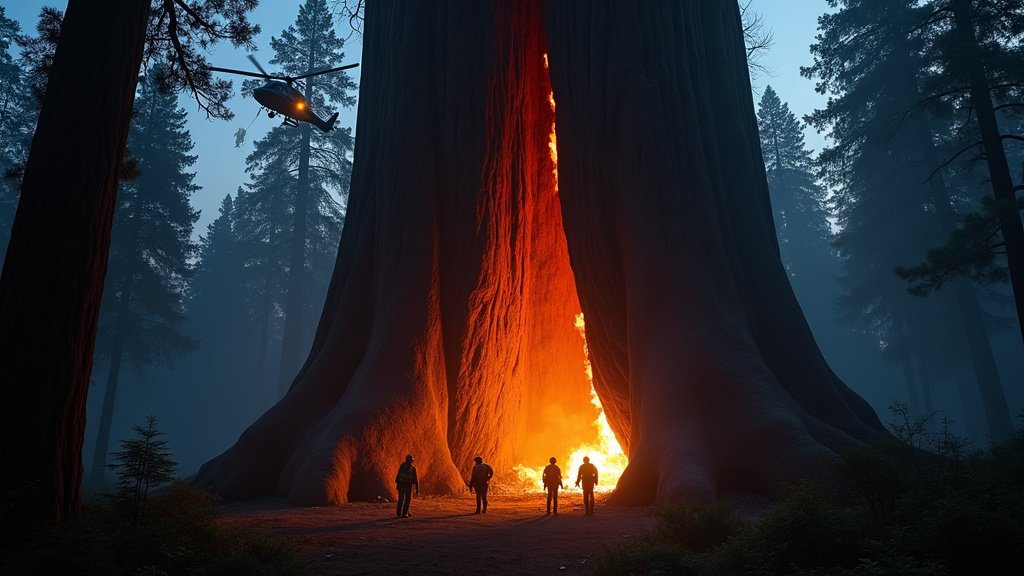In a disheartening development for conservationists and residents across the state, Oregon fire crews are engaged in a complex and challenging operation to extinguish a persistent blaze within the Doerner Fir, one of the world’s tallest and oldest trees. The iconic Douglas fir, a natural wonder nestled in the Coast Range Mountains, has been burning since August 16, sparking concern and drawing national attention to the unique difficulties of battling fires in such colossal arboreal giants. The incident has cast a spotlight on the vulnerability of ancient forests and the dedicated efforts of those striving to protect them.
The Doerner Fir: A Towering Legacy Under Threat
The Doerner Fir, also previously known as the Brummit Fir, stands as a testament to centuries of natural growth, reaching a staggering height of over 325 feet (99.1 meters) with a diameter of 11.5 feet (3.5 meters). Estimated to be between 450 and 500 years old, this coastal Douglas fir is not only the tallest tree in Oregon but also ranks among the world’s largest non-redwood trees. Its location, east of Coquille in Coos County on U.S. Bureau of Land Management (BLM) land, makes it a significant landmark and a cherished part of the region’s natural heritage. The fire, which reportedly ignited on Saturday, August 16, has unfortunately claimed approximately 50 feet of its top, raising questions about its future standing in global height rankings.
A Perplexing Blaze: High-Altitude Challenges and Unknown Origins
The fire presented an immediate and unusual challenge for responders. Initial reports indicated flames at the tree’s summit, which subsequently extended down its massive trunk. While helicopter drops successfully suppressed visible flames in the canopy, an infrared drone flight on Tuesday, August 19, revealed a persistent heat signature within a cavity inside the trunk, approximately 250 to 280 feet off the ground. This high-altitude internal burning has proven particularly difficult to tackle. Megan Harper, a public affairs specialist for the Bureau of Land Management, explained that accessing this specific hot spot to douse it with water has become the primary hurdle for firefighters.
Investigators from the BLM have definitively ruled out lightning as the cause of the fire, based on a review of recent weather data. This finding deepens the mystery surrounding the blaze’s origin, prompting ongoing investigations into potential human involvement. Chris Adlam, a regional wildland fire specialist at Oregon State University, noted that older trees are often hollow, increasing the chances of internal burning once ignited. The Doerner Fir remains the only tree affected in its immediate vicinity, with no spread to the surrounding forest, thanks to the swift actions of fire crews.
A Multi-Agency Response and Innovative Tactics
The Coos Forest Protective Association (Coos FPA) and the U.S. Bureau of Land Management are leading the intensive efforts to save the ancient fir. Firefighting strategies have included a combination of ground and air resources. Crews established a containment line around the base of the tree and deployed sprinklers to prevent any spread of flames at ground level. Helicopters equipped with buckets have conducted numerous water drops to target the upper sections of the tree. Drones have been instrumental, providing aerial imagery and infrared data to help firefighters assess the internal extent of the blaze and plan their next steps.
However, traditional methods like sending climbing crews directly into the tree have been deemed unsafe due to the risk of falling debris from the burning top. This has led officials to consider unconventional solutions, including building scaffolding or utilizing adjacent trees to gain better access to the burning cavity. The agencies are also consulting with master arborists, including one who has previously climbed the Doerner Fir, to develop safe and effective strategies to finally extinguish the internal fire.
Future of a Landmark: Resilience Amidst Damage
Despite the significant loss of height, officials remain optimistic about the Doerner Fir’s long-term survival. Megan Harper reassured the public that the sheer mass and structural integrity of the tree make it unlikely to burn down completely. “The tree is so big, it’s got so much mass that it would take a while for it to burn all the way through the tree,” Harper stated. While its stature may be diminished, it is expected to endure as a magnificent natural landmark.
In the interest of public safety and to facilitate firefighting operations, the Doerner Fir Recreation Area has been closed indefinitely. This ongoing news story highlights the fragility of our ancient ecosystems in the face of fires, even for seemingly impervious giants like the Doerner Fir. The determination to save this historic Oregon tree underscores the profound value placed on these irreplaceable natural treasures and the lengths to which dedicated crews will go to protect them.




